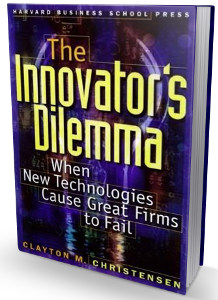 | |
| Author | Clayton Christensen |
|---|---|
| Language | English |
| Genre | Business theory |
| Publisher | Harvard Business Review Press; 1st edition (May 1, 1997) |
Publication date | 1997 |
| Publication place | United States |
| ISBN | 0875845851 |
| Followed by | The Innovator's Solution |
The Innovator's Dilemma: When New Technologies Cause Great Firms to Fail, first published in 1997, is the best-known work of the Harvard professor and businessman Clayton Christensen. It expands on the concept of disruptive technologies, a term he coined in a 1995 article "Disruptive Technologies: Catching the Wave".[1] It describes how large incumbent companies lose market share by listening to their customers and providing what appears to be the highest-value products, but new companies that serve low-value customers with poorly developed technology can improve that technology incrementally until it is good enough to quickly take market share from established business. Christensen recommends that large companies maintain small, nimble divisions that attempt to replicate this phenomenon internally to avoid being blindsided and overtaken by startup competitors.
- ^ Bower, Joseph L. & Christensen, Clayton M. (1995). However the concept of new technologies leading to wholesale economic change is not a new idea since Joseph Schumpeter adapted the idea of creative destruction from Karl Marx. Schumpeter (1949) in one of his examples used "the railroadization of the Middle West as it was initiated by the Illinois Central". He wrote, "The Illinois Central not only meant very good business whilst it was built and whilst new cities were built around it and land was cultivated, but it spelled the death sentence for the [old] agriculture of the West. "Disruptive Technologies: Catching the Wave" Harvard Business Review, January–February 1995.
